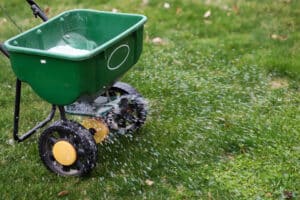A lush, green lawn is a hallmark of a well-kept home, but neglecting the edges can diminish the beauty of your landscape. Crisp, clean edging creates a visual frame that helps highlight your lawn while also providing a barrier to keep grass and weeds from encroaching on your driveway, sidewalks, and flower beds.
In this guide, we’ll walk you through the steps to edge your lawn. We’ll explain the tools you’ll need, how often to edge, and tips for working safely. Planting perennial native plants, choosing low-water hybrids, and installing artificial grass are increasingly popular methods of creating a low-maintenance landscape. If you want to go the traditional route and keep your grass trimmed, consider finding a top-rated lawn care company with a team that will do the edging for you.
Find Lawn Help
- See our list of top lawn care companies based on in-depth research.
- Select the company that best meets your needs.
- Get a free, no-obligation quote for your home.
Get a Quote From Lawn Professionals Near You
Get a quote in as little as 5 minutes
Clicking “Get Your Estimate” submits your data to Home Service Quotes, which will process your data in accordance with the Home Service Quotes Privacy Policy.

Lime Soil Amendment

Lawn Fertilization
Step 1: Mow the Grass
Mowing your lawn first sets you up for success with edging because it gives you a clear picture of the level of growth you’re dealing with and how long you want the grass alongside your edges to be. Plus, your lawn needs to be maintained at a certain length to remain healthy. While it might be tempting to take your grass down to the base, we generally recommend never taking off more than 1/3 of the grass blades at once. So, take note of that cut height. The blade setting you choose will give you a general idea of how deep you need to run your edger to reach healthy roots.
Step 2: Plan the Path
If this is your first time edging your lawn, or if it’s been a while, it’s a good idea to delineate your planned path with tape, a hose, or even rope. This temporary marker will help guide you when removing sod or installing materials. Don’t use spray paint since the wind may carry it away.
Step 3: Choose an Edger
Now, it’s time to choose your edger, power or manual. Power edgers, like string trimmers, will get the job done faster, but manual edgers will give you more control.
String Trimmers
String trimmers are often used as edgers, and some are called trimmers/edgers. These lightweight power tools can be electric, gas, corded, or cordless. They feature a long shaft with a spinning head at the bottom. The spinning head uses a monofilament string to create centrifugal force that cuts through grass and weeds.
Gas trimmers work best for large lawns, and electric trimmers are more environmentally friendly. Cordless trimmers are portable and lightweight and run on batteries.
Manual Edgers
There are different kinds of manual edgers. They require more effort, and the work often takes longer, but they can be more precise.
- Landscaping edgers: These have a 3–4 foot shaft with a half-moon steel blade at the bottom, with footrests on either side. These are best used for removing grass and sod growing over a pathway or driveway or for removing turf next to a flower bed. There are also manual edgers with wooden shafts, which are lighter than their steel counterparts.
- Dual wheel rotary edgers: Dual wheel rotary edgers feature serrated blades attached to one side of a rubber wheel. That side slices through grass growing over the edges of driveways and walkways while the other wheel rolls along the grass.
- Edging shears: Edging shears are primarily used for touch-ups. Homeowners use them to remove any excess turf from their lawn’s edge.
Step 4: Put on Safety Gear
Put on a sturdy pair of gloves and a pair of safety glasses to shield your eyes from grass, pollen, and any debris. You may also wear a face mask to protect your nose and mouth if you are sensitive to allergens.
Step 5: Edge the Perimeter
Now, the edging begins. Before you get started, make sure you know where any electrical wires, plumbing pipes, or other buried hazards may be. You don’t want to risk cutting into them with your edger, so make sure to give them a wide berth.
You may want to do a practice edge to get familiar with the movements. We recommend doing that in a part of your lawn that isn’t too visible or in your backyard.
How To Edge With a String Trimmer
Flip the head of the trimmer 180 degrees, making it vertical, with the deflector shield facing toward your body. Walk on the hard surface of the walkway or driveway as you edge.
The form you should take is simple. Keep your arms straight, engage your core, and move your body with deliberate movements, keeping the string trimmer level. This will give you the straightest edge. Be mindful of the direction your string trimmer spins, and move accordingly. Most of them spin the string clockwise, so you should move left to right while trimming—the trimmings will fall back onto the lawn.
For power edgers and manual edgers, cut just about 2 inches deep.
How To Edge With a Manual Edger
Using a manual edger is a lot like using a shovel. Drive it straight down into the ground with your feet, so the lip at the bottom touches the soil. Make sure it’s completely straight—that will make your edge more defined. Rock the edger side-to-side, then gently pull the handle back up.
Step 6: Check for Jagged Areas
Shovel up loose soil, turf, or mulch periodically as you go along, and place it in a wheelbarrow. This will give you a good sense of your edging so you can tell if there are any jagged areas you may need to go over again.
Step 7: Edge Garden Beds
Manual edgers may be your best bet when edging along curved garden beds since they can create more fluid edges. Mark the area you want to edge, and follow the same steps for manual edging a perimeter. Go slow and steady, with deliberate movement.
Step 8: Prune and Trim Shrubs and Bushes
Once your perimeter and curved pathways are taken care of, take your edging shears and prune your shrubs and bushes. Going in small, regular sections will help make the shapes even.
Step 9: Clean Up Debris
After you’ve finished edging, use a stiff brush to clean all grass, soil, and residue from your trimmer, edger, or edging shears. If any debris dries and hardens, it will make it difficult to use the equipment the next time around.
Step 10: Maintain Your Lawn
After all that work, you’ll want to keep your lawn in tip-top shape. We recommend hiring a professional lawn care company like TruGreen to handle your lawn’s weed control, fertilization, aeration, and more.
FAQs About Edging a Lawn
What is the best way to edge a lawn?
The best way to edge your lawn is to follow our 10 simple steps, starting with mowing and ending with maintenance. Be sure to choose the best edger—or edgers—for your lawn for the best results. Always try to walk on the hard surface, like your driveway or walkway, as you edge.
What is the best tool for edging a lawn?
There are a variety of tools to edge your lawn, from power edgers like string trimmers to manual edgers with half-moon blades to even edging shears. The best tool will depend on your budget, the amount of time you have, and the shape of the edges you need to create.
How do I manually edge my lawn?
Treat your manual edger as you would a shovel. Drive it gently down into the ground, keeping it as straight as possible, with your feet, until the lip meets the soil. Rock the edger side-to-side, then gently pull the handle up to make your edge.
How can I edge my lawn without an edger?
You can start by lowering the cutting blade on your lawn mower and shaving cleanly down your lawn. Then, you can install permanent lawn edging, often made of rubber or steel. Another option is laying down lawn edging pavers, which you place in a prepared trench.
Our Rating Methodology
The This Old House Reviews Team backs up our lawn recommendations with a detailed rating methodology that we use to objectively score each provider. We review lawn care plans and packages, navigate the provider website and speak with customer service representatives, request quotes, and analyze customer reviews for each provider. We then score the provider against our review standards for plan options, additional benefits and customizability, availability, trustworthiness, and customer service to arrive at a final score on a 5-point rating scale.


